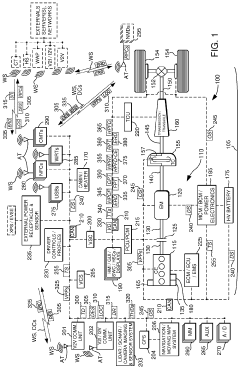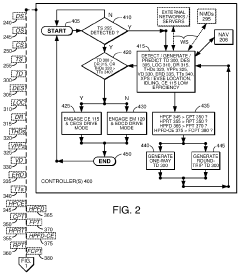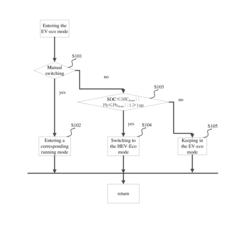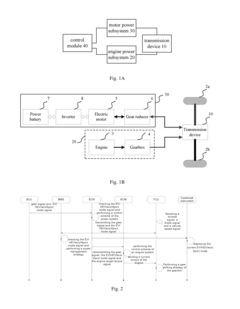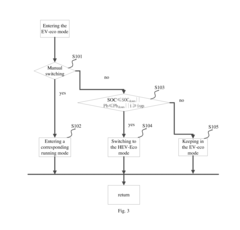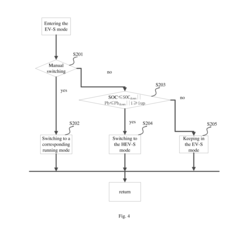Navigating HEV Standards: Global Perspectives
AUG 14, 20258 MIN READ
Generate Your Research Report Instantly with AI Agent
Patsnap Eureka helps you evaluate technical feasibility & market potential.
HEV Standards Evolution
The evolution of Hybrid Electric Vehicle (HEV) standards has been a dynamic process, reflecting the rapid advancements in automotive technology and the growing global emphasis on sustainable transportation. This progression can be traced through several key phases, each marked by significant technological milestones and regulatory developments.
In the early 1990s, the initial HEV standards primarily focused on basic safety requirements and emissions regulations. These early standards were largely fragmented, with different regions developing their own sets of guidelines. The United States, Japan, and Europe emerged as pioneers in this field, each establishing foundational frameworks that would shape future global standards.
The turn of the millennium saw a shift towards more comprehensive and harmonized standards. This period was characterized by the introduction of more stringent emissions regulations, such as the European Union's Euro standards and the United States' EPA Tier 2 standards. These regulations indirectly influenced HEV development by pushing automakers to explore more efficient powertrain technologies.
From 2005 to 2015, there was a significant push towards standardization of HEV components and systems. This phase saw the development of standards for battery management systems, power electronics, and charging interfaces. The SAE J1772 standard for electric vehicle charging connectors, introduced in 2001 and revised in 2009, became a crucial benchmark for HEV charging infrastructure.
The most recent phase, from 2015 onwards, has been marked by a focus on interoperability and global harmonization. The development of ISO 15118 for vehicle-to-grid communication exemplifies this trend, aiming to create a unified standard for intelligent charging across different manufacturers and regions. Additionally, there has been increased attention to cybersecurity standards for HEVs, recognizing the growing connectivity of these vehicles.
Throughout this evolution, a notable trend has been the shift from reactive to proactive standard-setting. Early standards were often developed in response to technological advancements, while more recent efforts have aimed to anticipate future needs and guide innovation. This approach is evident in the development of standards for vehicle-to-everything (V2X) communication and autonomous driving capabilities in HEVs.
The evolution of HEV standards has also been influenced by broader automotive industry trends, such as the push for electrification and the advent of connected and autonomous vehicles. As a result, modern HEV standards increasingly intersect with those for fully electric vehicles and smart mobility systems, reflecting the blurring lines between these technologies.
In the early 1990s, the initial HEV standards primarily focused on basic safety requirements and emissions regulations. These early standards were largely fragmented, with different regions developing their own sets of guidelines. The United States, Japan, and Europe emerged as pioneers in this field, each establishing foundational frameworks that would shape future global standards.
The turn of the millennium saw a shift towards more comprehensive and harmonized standards. This period was characterized by the introduction of more stringent emissions regulations, such as the European Union's Euro standards and the United States' EPA Tier 2 standards. These regulations indirectly influenced HEV development by pushing automakers to explore more efficient powertrain technologies.
From 2005 to 2015, there was a significant push towards standardization of HEV components and systems. This phase saw the development of standards for battery management systems, power electronics, and charging interfaces. The SAE J1772 standard for electric vehicle charging connectors, introduced in 2001 and revised in 2009, became a crucial benchmark for HEV charging infrastructure.
The most recent phase, from 2015 onwards, has been marked by a focus on interoperability and global harmonization. The development of ISO 15118 for vehicle-to-grid communication exemplifies this trend, aiming to create a unified standard for intelligent charging across different manufacturers and regions. Additionally, there has been increased attention to cybersecurity standards for HEVs, recognizing the growing connectivity of these vehicles.
Throughout this evolution, a notable trend has been the shift from reactive to proactive standard-setting. Early standards were often developed in response to technological advancements, while more recent efforts have aimed to anticipate future needs and guide innovation. This approach is evident in the development of standards for vehicle-to-everything (V2X) communication and autonomous driving capabilities in HEVs.
The evolution of HEV standards has also been influenced by broader automotive industry trends, such as the push for electrification and the advent of connected and autonomous vehicles. As a result, modern HEV standards increasingly intersect with those for fully electric vehicles and smart mobility systems, reflecting the blurring lines between these technologies.
Global Market Demand
The global market demand for Hybrid Electric Vehicles (HEVs) has been experiencing significant growth in recent years, driven by increasing environmental concerns, stricter emissions regulations, and rising fuel costs. This trend is expected to continue as governments worldwide implement more stringent fuel economy standards and offer incentives for the adoption of cleaner transportation technologies.
In major automotive markets such as North America, Europe, and Asia-Pacific, consumer interest in HEVs has been steadily rising. This is particularly evident in urban areas where air quality concerns are more pronounced, and in regions with high fuel prices. The demand for HEVs is also being fueled by corporate and fleet customers looking to reduce their carbon footprint and operating costs.
The Asia-Pacific region, led by countries like Japan and China, has emerged as a key market for HEVs. Japan, in particular, has been at the forefront of HEV adoption, with a well-established market and strong government support. China, with its rapidly growing automotive sector and focus on reducing urban air pollution, is also seeing a surge in HEV demand.
In Europe, the push towards electrification has been driven by stringent EU emissions regulations. Countries like Germany, France, and the UK are witnessing increased consumer interest in HEVs as a transitional technology between conventional internal combustion engine vehicles and fully electric vehicles.
The North American market, while initially slower to adopt HEVs compared to other regions, has seen growing demand in recent years. This is partly due to improved fuel efficiency and performance of newer HEV models, as well as increased awareness of environmental issues among consumers.
Emerging markets in South America and Africa are also showing potential for HEV growth, albeit at a slower pace. These regions are likely to see increased demand as HEV technology becomes more affordable and as local governments implement supportive policies.
The global HEV market is expected to continue its upward trajectory, with projections indicating substantial growth over the next decade. This growth is likely to be accompanied by technological advancements, cost reductions, and an expanding range of HEV models across various vehicle segments.
However, the HEV market also faces challenges, including competition from fully electric vehicles, potential changes in government policies and incentives, and the need for standardization of charging infrastructure. These factors will play a crucial role in shaping the future demand for HEVs in different global markets.
In major automotive markets such as North America, Europe, and Asia-Pacific, consumer interest in HEVs has been steadily rising. This is particularly evident in urban areas where air quality concerns are more pronounced, and in regions with high fuel prices. The demand for HEVs is also being fueled by corporate and fleet customers looking to reduce their carbon footprint and operating costs.
The Asia-Pacific region, led by countries like Japan and China, has emerged as a key market for HEVs. Japan, in particular, has been at the forefront of HEV adoption, with a well-established market and strong government support. China, with its rapidly growing automotive sector and focus on reducing urban air pollution, is also seeing a surge in HEV demand.
In Europe, the push towards electrification has been driven by stringent EU emissions regulations. Countries like Germany, France, and the UK are witnessing increased consumer interest in HEVs as a transitional technology between conventional internal combustion engine vehicles and fully electric vehicles.
The North American market, while initially slower to adopt HEVs compared to other regions, has seen growing demand in recent years. This is partly due to improved fuel efficiency and performance of newer HEV models, as well as increased awareness of environmental issues among consumers.
Emerging markets in South America and Africa are also showing potential for HEV growth, albeit at a slower pace. These regions are likely to see increased demand as HEV technology becomes more affordable and as local governments implement supportive policies.
The global HEV market is expected to continue its upward trajectory, with projections indicating substantial growth over the next decade. This growth is likely to be accompanied by technological advancements, cost reductions, and an expanding range of HEV models across various vehicle segments.
However, the HEV market also faces challenges, including competition from fully electric vehicles, potential changes in government policies and incentives, and the need for standardization of charging infrastructure. These factors will play a crucial role in shaping the future demand for HEVs in different global markets.
Technical Challenges
The development of Hybrid Electric Vehicle (HEV) standards faces several significant technical challenges on a global scale. One of the primary obstacles is the lack of harmonization among different countries and regions. Each market has its own set of regulations and standards, making it difficult for manufacturers to create universally compliant vehicles. This fragmentation leads to increased development costs and longer time-to-market for new HEV models.
Another major challenge lies in the rapidly evolving nature of HEV technology. As innovations in battery technology, power electronics, and electric motors continue to advance, standards struggle to keep pace. This creates a gap between cutting-edge HEV designs and existing regulatory frameworks, potentially hindering the adoption of more efficient and environmentally friendly solutions.
The integration of HEVs with existing infrastructure presents another set of technical hurdles. Charging standards, for instance, vary widely across different countries, with competing protocols such as CHAdeMO, CCS, and Tesla's proprietary system. This lack of standardization complicates the development of a unified charging network and can lead to consumer confusion and range anxiety.
Safety standards for HEVs also pose significant challenges. The high-voltage systems in these vehicles require specialized safety protocols and testing procedures. Developing comprehensive safety standards that address the unique risks associated with HEVs, such as battery thermal runaway and electrical isolation, is an ongoing process that requires continuous refinement as technology evolves.
Electromagnetic compatibility (EMC) is another critical area of concern. HEVs generate significant electromagnetic interference due to their high-power electrical systems. Ensuring that these vehicles comply with EMC standards while maintaining performance and efficiency is a complex technical challenge that requires sophisticated engineering solutions.
The environmental impact of HEVs throughout their lifecycle is also a subject of intense scrutiny. Developing standards that accurately measure and regulate the carbon footprint of these vehicles, from production to end-of-life recycling, is a complex task. This includes addressing issues such as battery production emissions, the use of rare earth elements, and the development of sustainable recycling processes for HEV components.
Lastly, the challenge of data privacy and cybersecurity in connected HEVs is becoming increasingly important. As these vehicles become more integrated with smart grid systems and autonomous driving technologies, ensuring the security of vehicle-to-grid communication and protecting sensitive user data becomes crucial. Developing robust standards for cybersecurity in HEVs is an ongoing challenge that requires collaboration between automotive, IT, and regulatory experts.
Another major challenge lies in the rapidly evolving nature of HEV technology. As innovations in battery technology, power electronics, and electric motors continue to advance, standards struggle to keep pace. This creates a gap between cutting-edge HEV designs and existing regulatory frameworks, potentially hindering the adoption of more efficient and environmentally friendly solutions.
The integration of HEVs with existing infrastructure presents another set of technical hurdles. Charging standards, for instance, vary widely across different countries, with competing protocols such as CHAdeMO, CCS, and Tesla's proprietary system. This lack of standardization complicates the development of a unified charging network and can lead to consumer confusion and range anxiety.
Safety standards for HEVs also pose significant challenges. The high-voltage systems in these vehicles require specialized safety protocols and testing procedures. Developing comprehensive safety standards that address the unique risks associated with HEVs, such as battery thermal runaway and electrical isolation, is an ongoing process that requires continuous refinement as technology evolves.
Electromagnetic compatibility (EMC) is another critical area of concern. HEVs generate significant electromagnetic interference due to their high-power electrical systems. Ensuring that these vehicles comply with EMC standards while maintaining performance and efficiency is a complex technical challenge that requires sophisticated engineering solutions.
The environmental impact of HEVs throughout their lifecycle is also a subject of intense scrutiny. Developing standards that accurately measure and regulate the carbon footprint of these vehicles, from production to end-of-life recycling, is a complex task. This includes addressing issues such as battery production emissions, the use of rare earth elements, and the development of sustainable recycling processes for HEV components.
Lastly, the challenge of data privacy and cybersecurity in connected HEVs is becoming increasingly important. As these vehicles become more integrated with smart grid systems and autonomous driving technologies, ensuring the security of vehicle-to-grid communication and protecting sensitive user data becomes crucial. Developing robust standards for cybersecurity in HEVs is an ongoing challenge that requires collaboration between automotive, IT, and regulatory experts.
Current HEV Standards
01 HEV light measurement and testing standards
Standards for measuring and testing High Energy Visible (HEV) light exposure are developed to ensure consistent evaluation of HEV effects. These standards may include protocols for measuring HEV light intensity, duration of exposure, and spectral characteristics. They help in assessing the potential impact of HEV light on various materials, devices, and biological systems.- HEV light measurement and testing standards: Standards for measuring and testing High Energy Visible (HEV) light exposure are developed to ensure consistent evaluation of HEV effects. These standards may include protocols for measuring HEV light intensity, duration of exposure, and spectral characteristics. They help in assessing the potential impact of HEV light on various materials, devices, and biological systems.
- HEV protection in electronic displays: Standards for HEV protection in electronic displays focus on reducing the emission of high-energy visible light from screens. These may include specifications for blue light filters, screen coatings, or software solutions that adjust color temperature. The aim is to minimize potential eye strain and circadian rhythm disruption associated with prolonged screen use.
- HEV-resistant materials and coatings: Standards for HEV-resistant materials and coatings are developed to ensure protection against high-energy visible light in various applications. These standards may specify the required properties, testing methods, and performance criteria for materials used in protective eyewear, window films, and other products designed to block or filter HEV light.
- HEV safety standards for lighting systems: Safety standards for lighting systems regarding HEV emissions are established to regulate the amount of high-energy visible light produced by artificial light sources. These standards may include limits on blue light content, requirements for protective measures, and guidelines for the design and installation of lighting systems to minimize potential health risks associated with HEV exposure.
- HEV exposure limits in occupational settings: Occupational health and safety standards related to HEV exposure are developed to protect workers in environments with high levels of high-energy visible light. These standards may define maximum exposure limits, recommend protective equipment, and outline best practices for minimizing HEV-related risks in various industries and workplaces.
02 HEV protection in electronic displays
Standards for HEV protection in electronic displays focus on reducing the emission of high-energy visible light from screens. These may include specifications for blue light filters, screen coatings, or software solutions that adjust color temperature. The aim is to minimize potential eye strain and sleep disruption associated with prolonged exposure to HEV light from digital devices.Expand Specific Solutions03 HEV-resistant materials and coatings
Standards for HEV-resistant materials and coatings are established to ensure the durability and effectiveness of products exposed to high-energy visible light. These standards may cover testing methods for UV and HEV resistance, performance criteria for protective coatings, and guidelines for developing materials that can withstand prolonged HEV exposure without degradation.Expand Specific Solutions04 HEV safety standards in lighting
Safety standards for HEV in lighting applications are developed to address potential health concerns related to high-energy visible light exposure. These standards may include guidelines for maximum HEV emission levels in various lighting products, recommendations for safe exposure durations, and requirements for labeling and consumer information regarding HEV content in light sources.Expand Specific Solutions05 HEV standards in skincare and cosmetics
Standards for HEV protection in skincare and cosmetic products are established to address the potential effects of high-energy visible light on skin. These standards may include testing protocols for HEV protection efficacy, guidelines for formulating HEV-protective ingredients, and labeling requirements for products claiming HEV protection. The aim is to ensure consistent and reliable HEV protection in personal care products.Expand Specific Solutions
Key Industry Players
The global HEV standards landscape is characterized by a competitive and rapidly evolving market. As the industry transitions from early adoption to mainstream acceptance, major automotive players are vying for market share and technological leadership. Companies like Ford, Hyundai, Toyota, and GM are at the forefront, investing heavily in R&D and production capabilities. The market size is expanding significantly, driven by increasing environmental regulations and consumer demand for fuel-efficient vehicles. Technologically, HEV standards are maturing, with established players like Toyota and Honda leading in hybrid technology, while newer entrants like BYD and Geely are making strides in electric vehicle integration. The competition is fierce, with companies racing to develop more efficient powertrains, advanced battery technologies, and seamless integration of electric and combustion systems.
Ford Global Technologies LLC
Technical Solution: Ford has been actively developing and implementing HEV technologies to meet global standards and market demands. Their PowerSplit hybrid architecture, used in vehicles like the Ford Fusion Hybrid, combines the benefits of both series and parallel hybrid systems. This technology allows for efficient power distribution between the engine and electric motor, optimizing fuel economy and performance[2]. Ford has also been focusing on standardizing their hybrid powertrain components across different vehicle platforms, which helps in meeting various international regulations more cost-effectively. Recently, Ford announced plans to invest $11 billion in electrification, including HEVs, by 2022, demonstrating their commitment to advancing hybrid technology and meeting evolving global standards[4].
Strengths: Strong R&D capabilities, diverse vehicle portfolio for implementing HEV technology. Weaknesses: Later entry into the HEV market compared to some competitors, potentially playing catch-up in some aspects of technology and market share.
Hyundai Motor Co., Ltd.
Technical Solution: Hyundai has been making significant strides in HEV technology and standards compliance. Their approach includes the development of a modular hybrid powertrain system that can be adapted to various vehicle sizes and types, allowing for greater flexibility in meeting different regional standards. Hyundai's latest HEV models feature advanced regenerative braking systems that capture up to 70% of the vehicle's kinetic energy, significantly improving overall efficiency[6]. The company has also been working on standardizing their hybrid control algorithms across their vehicle lineup, which helps in optimizing performance and emissions across different markets. Hyundai's commitment to HEV technology is part of their broader strategy to offer 44 eco-friendly models by 2025, including HEVs, plug-in hybrids, and full electric vehicles[7].
Strengths: Rapid technological advancement, strong presence in emerging markets. Weaknesses: Relatively newer entrant in some established HEV markets, potentially facing challenges in brand perception compared to long-standing hybrid leaders.
Core HEV Innovations
Hybrid electric vehicle fuel conservation system
PatentActiveUS10793135B2
Innovation
- The implementation of advanced controller systems that estimate trip distances, detect thermal demands, and adjust drive modes based on real-time data from navigation systems, sensors, and historical probabilities to optimize the engagement of electric drive modes and combustion engine modes, ensuring efficient energy use and minimizing fuel consumption.
Control system of hybrid electrical vehicle and control method for the same
PatentActiveUS20160221570A1
Innovation
- A control system and method for a hybrid electrical vehicle that allows operation in hybrid-electrical economical mode by connecting the engine power subsystem and motor power subsystem in parallel, enabling flexible power matching and reducing the complexity of Electronic Continuously Variable Transmission (ECVT) systems, thereby improving energy utilization and driving comfort.
Regulatory Framework
The regulatory framework for Hybrid Electric Vehicles (HEVs) is a complex and evolving landscape, shaped by diverse global perspectives and regional priorities. At the international level, the United Nations Economic Commission for Europe (UNECE) plays a crucial role in harmonizing standards through its World Forum for Harmonization of Vehicle Regulations (WP.29). This body has developed several regulations specifically addressing HEVs, including those related to emissions, energy consumption, and safety.
In the European Union, the regulatory approach is driven by ambitious climate goals and a push towards sustainable mobility. The EU has implemented stringent CO2 emission standards for new passenger cars and light commercial vehicles, incentivizing the adoption of HEV technologies. Additionally, the EU's type-approval system ensures that vehicles meet safety and environmental standards before entering the market.
The United States presents a unique regulatory environment, with federal and state-level regulations often diverging. At the federal level, the Corporate Average Fuel Economy (CAFE) standards and greenhouse gas emissions regulations, administered by the National Highway Traffic Safety Administration (NHTSA) and the Environmental Protection Agency (EPA), respectively, have been instrumental in promoting HEV technologies. California, with its Zero Emission Vehicle (ZEV) program, has been at the forefront of pushing for more stringent standards, often influencing national policies.
In Asia, countries like Japan and China have taken proactive steps in regulating and promoting HEVs. Japan's Top Runner Program sets efficiency standards for various products, including vehicles, driving innovation in HEV technology. China, the world's largest automotive market, has implemented a dual-credit policy that encourages manufacturers to produce new energy vehicles, including HEVs.
Emerging markets are also developing regulatory frameworks to address HEVs, often adapting policies from more established markets while considering local conditions. India, for example, has introduced the Faster Adoption and Manufacturing of Hybrid and Electric Vehicles (FAME) scheme to promote electrification of the transport sector.
A key challenge in the global regulatory landscape is the lack of complete harmonization, which can create barriers for manufacturers and potentially slow down technological advancements. Efforts are ongoing to align standards and testing procedures across regions, with initiatives like the Worldwide Harmonized Light Vehicles Test Procedure (WLTP) representing significant progress in this direction.
In the European Union, the regulatory approach is driven by ambitious climate goals and a push towards sustainable mobility. The EU has implemented stringent CO2 emission standards for new passenger cars and light commercial vehicles, incentivizing the adoption of HEV technologies. Additionally, the EU's type-approval system ensures that vehicles meet safety and environmental standards before entering the market.
The United States presents a unique regulatory environment, with federal and state-level regulations often diverging. At the federal level, the Corporate Average Fuel Economy (CAFE) standards and greenhouse gas emissions regulations, administered by the National Highway Traffic Safety Administration (NHTSA) and the Environmental Protection Agency (EPA), respectively, have been instrumental in promoting HEV technologies. California, with its Zero Emission Vehicle (ZEV) program, has been at the forefront of pushing for more stringent standards, often influencing national policies.
In Asia, countries like Japan and China have taken proactive steps in regulating and promoting HEVs. Japan's Top Runner Program sets efficiency standards for various products, including vehicles, driving innovation in HEV technology. China, the world's largest automotive market, has implemented a dual-credit policy that encourages manufacturers to produce new energy vehicles, including HEVs.
Emerging markets are also developing regulatory frameworks to address HEVs, often adapting policies from more established markets while considering local conditions. India, for example, has introduced the Faster Adoption and Manufacturing of Hybrid and Electric Vehicles (FAME) scheme to promote electrification of the transport sector.
A key challenge in the global regulatory landscape is the lack of complete harmonization, which can create barriers for manufacturers and potentially slow down technological advancements. Efforts are ongoing to align standards and testing procedures across regions, with initiatives like the Worldwide Harmonized Light Vehicles Test Procedure (WLTP) representing significant progress in this direction.
Environmental Impact
The environmental impact of Hybrid Electric Vehicles (HEVs) is a critical consideration in the global automotive landscape. As nations strive to reduce carbon emissions and combat climate change, HEVs have emerged as a transitional technology between conventional internal combustion engine vehicles and fully electric vehicles.
HEVs contribute to reduced greenhouse gas emissions compared to traditional vehicles, primarily due to their improved fuel efficiency. By combining an internal combustion engine with an electric motor, HEVs can optimize energy usage, resulting in lower fuel consumption and consequently reduced CO2 emissions. This reduction varies depending on the specific HEV model, driving conditions, and energy sources used for electricity generation.
The production of HEVs, however, presents its own set of environmental challenges. The manufacturing process of batteries, electric motors, and other specialized components can be energy-intensive and may involve the extraction of rare earth elements. This raises concerns about resource depletion and the environmental impact of mining activities.
End-of-life considerations for HEVs are also significant. The disposal and recycling of batteries and electronic components require specialized processes to prevent environmental contamination. Many countries are developing regulations and infrastructure to address these challenges, but the global approach remains inconsistent.
The overall lifecycle assessment of HEVs compared to conventional vehicles shows a net positive environmental impact in most scenarios. However, the extent of this benefit varies depending on factors such as electricity grid composition, vehicle usage patterns, and manufacturing processes.
As global HEV standards evolve, there is an increasing focus on incorporating environmental impact assessments into regulatory frameworks. This includes considerations for manufacturing processes, energy efficiency standards, and end-of-life management. Some countries are implementing stricter regulations on the carbon footprint of vehicle production, while others are incentivizing the use of sustainable materials in HEV manufacturing.
The environmental impact of HEVs extends beyond direct emissions to include broader ecosystem effects. For instance, the reduced noise pollution from HEVs in urban environments can have positive impacts on human health and wildlife. Additionally, the potential for HEVs to integrate with smart grid systems and act as mobile energy storage units could contribute to more efficient energy management and further environmental benefits.
HEVs contribute to reduced greenhouse gas emissions compared to traditional vehicles, primarily due to their improved fuel efficiency. By combining an internal combustion engine with an electric motor, HEVs can optimize energy usage, resulting in lower fuel consumption and consequently reduced CO2 emissions. This reduction varies depending on the specific HEV model, driving conditions, and energy sources used for electricity generation.
The production of HEVs, however, presents its own set of environmental challenges. The manufacturing process of batteries, electric motors, and other specialized components can be energy-intensive and may involve the extraction of rare earth elements. This raises concerns about resource depletion and the environmental impact of mining activities.
End-of-life considerations for HEVs are also significant. The disposal and recycling of batteries and electronic components require specialized processes to prevent environmental contamination. Many countries are developing regulations and infrastructure to address these challenges, but the global approach remains inconsistent.
The overall lifecycle assessment of HEVs compared to conventional vehicles shows a net positive environmental impact in most scenarios. However, the extent of this benefit varies depending on factors such as electricity grid composition, vehicle usage patterns, and manufacturing processes.
As global HEV standards evolve, there is an increasing focus on incorporating environmental impact assessments into regulatory frameworks. This includes considerations for manufacturing processes, energy efficiency standards, and end-of-life management. Some countries are implementing stricter regulations on the carbon footprint of vehicle production, while others are incentivizing the use of sustainable materials in HEV manufacturing.
The environmental impact of HEVs extends beyond direct emissions to include broader ecosystem effects. For instance, the reduced noise pollution from HEVs in urban environments can have positive impacts on human health and wildlife. Additionally, the potential for HEVs to integrate with smart grid systems and act as mobile energy storage units could contribute to more efficient energy management and further environmental benefits.
Unlock deeper insights with Patsnap Eureka Quick Research — get a full tech report to explore trends and direct your research. Try now!
Generate Your Research Report Instantly with AI Agent
Supercharge your innovation with Patsnap Eureka AI Agent Platform!
